Benefits of Various Urban Green Spaces for Public Health Based on Landscape Elements: A Study of Public Visual Perception
Abstract
1. Introduction
2. Materials and Methods
2.1. Study Area and Materials
2.2. Landscape Elements Extraction
2.2.1. Qualitative Analysis and Selection of Indicators for Landscape Elements
2.2.2. Semantic Segmentation of Visual Materials
2.3. Public Perception of Response
2.3.1. Physiological Responses and Indicators
2.3.2. Psychological Responses and Indicators
2.3.3. Attention Recovery Indicators
2.4. Experimental Subjects
2.5. Experimental Design
2.6. Data Analysis
3. Results
3.1. Public Physiological Responses to Different Urban Green Spaces
3.2. Public Psychological Response to Green Spaces in Different Cities
3.3. Public Attention Responses in Different Urban Green Space
3.4. Relationships Between Landscape Elements and Public Physiological and Psychological Responses
3.4.1. Correlation Between Different Public Response Indicators
3.4.2. Correlation Between Landscape Elements and Public Response
3.4.3. Mechanisms of Public Health Impacts of Landscape Element Indicators
4. Discussion
4.1. Impact of Vision-Based Urban Green Space on Public Physiological and Psychological Health
4.2. Impact of Landscape Element Composition on Public Health Benefits
4.3. Urban Green Space Planning and Enhancement Strategies Based on Landscape Elements
4.4. Limitations and Future Research Perspectives
5. Conclusions
Author Contributions
Funding
Data Availability Statement
Acknowledgments
Conflicts of Interest
Abbreviations
| STAI | State of Anxiety Inventory | T | Tension |
| POMS | State of Mind Scale | I | Irritability |
| PRS | Perceived Restorative Scale | ΔP | Relative Changes in Psychological States |
| SBE | Scenic Beauty Estimation | PE | Plant Element |
| SD | Semantic Differential | WE | Water Element |
| AHP | Analytical Hierarchy Process | SKE | Sky Element |
| FCN | Fully Convolutional Networks | EME | Earth and Mountain Element |
| PSPNet | Pyramid Scene Parsing Network | BAE | Building and Artificial Element |
| B | Blank Group | RTE | Roads and Traffic Element |
| F | Forest Group | SEE | Spatial Enclosure Element |
| R | Residential Green Space Group | CNEE | Contribution of Natural Element to Enclosure |
| S | Street Green Space Group | NI | Naturalness Index |
| U | Urban Park Group | AI | Artificiality Index |
| W | Wetland Group | EI | Enclosure Index |
| HR | Heart Rate | Be A | Being Away |
| SC | Skin Conductance | Fas | Fascination |
| EEG | Electroencephalography | Coh | Coherence |
| C | Calmness | Comp | Compatibility |
Appendix A
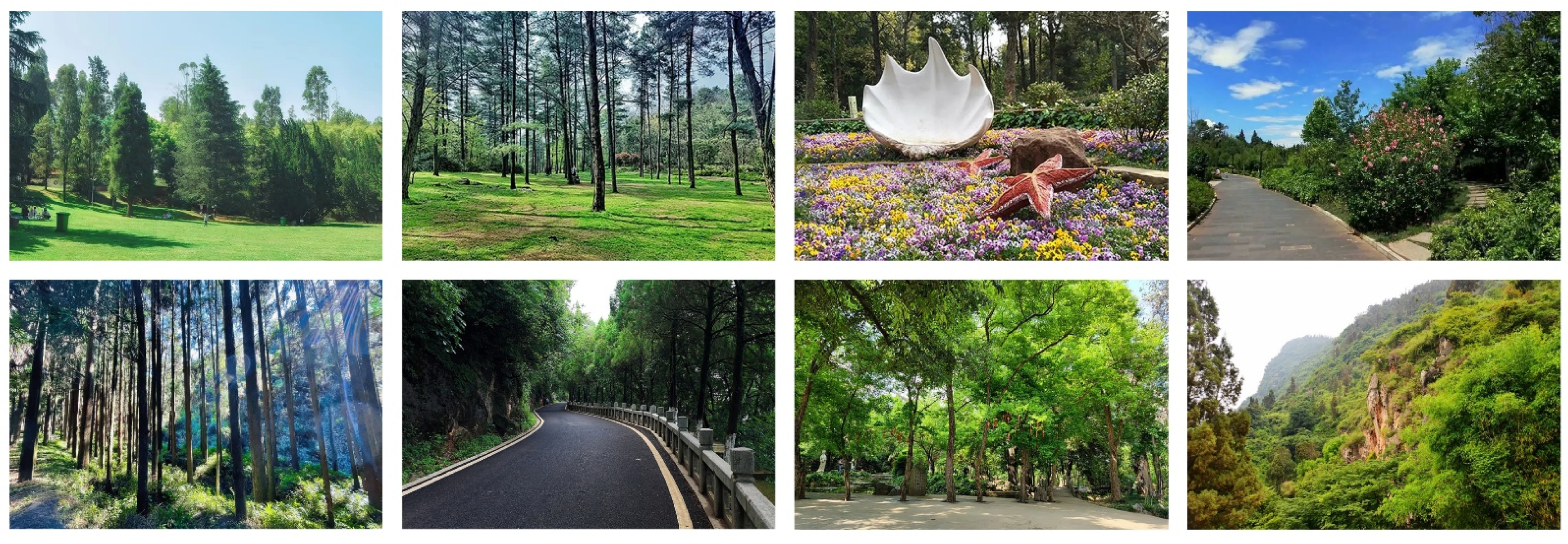
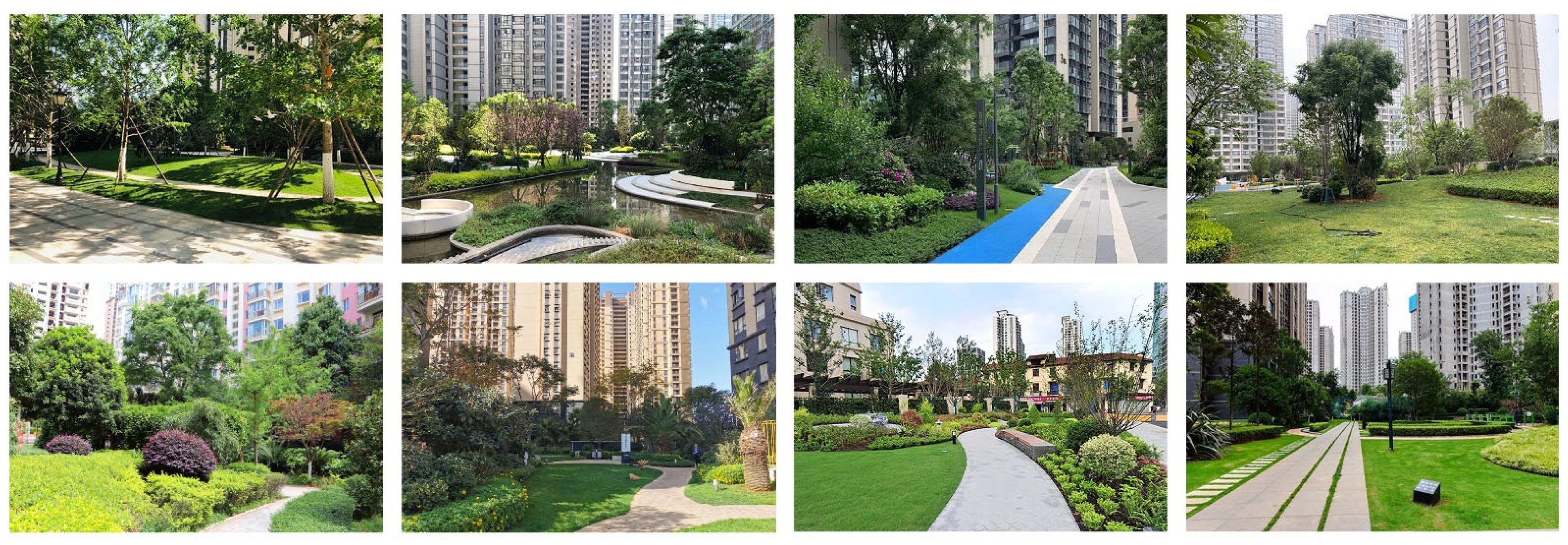
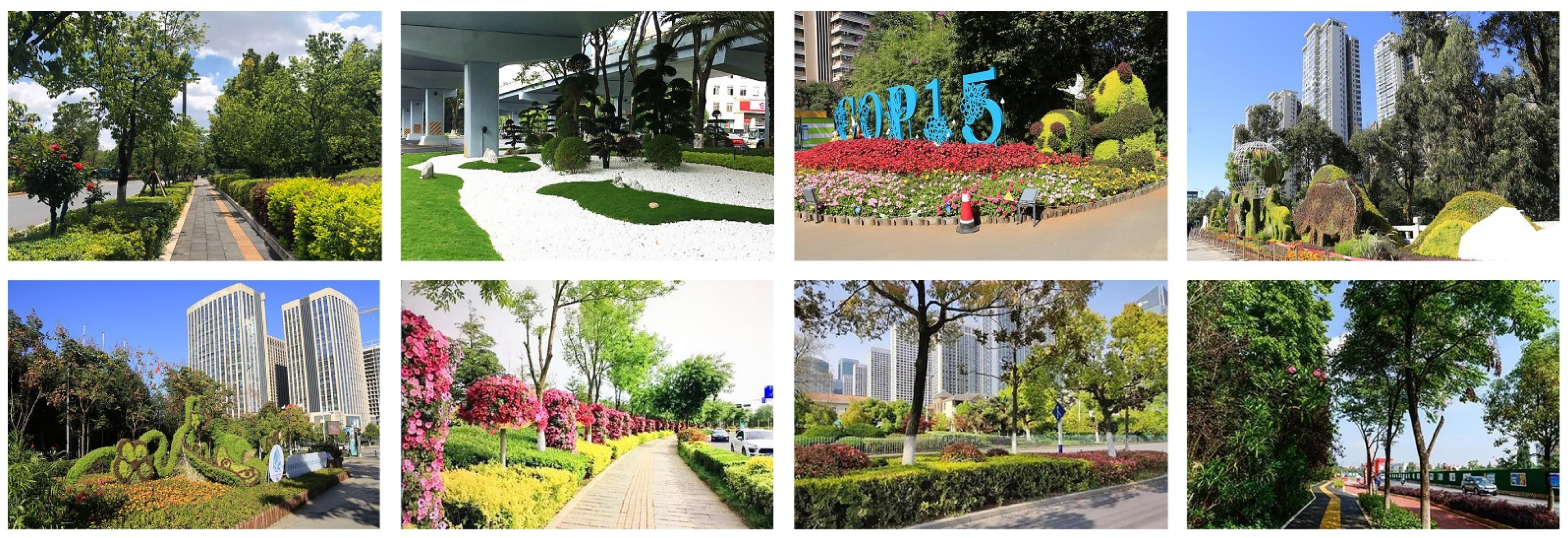

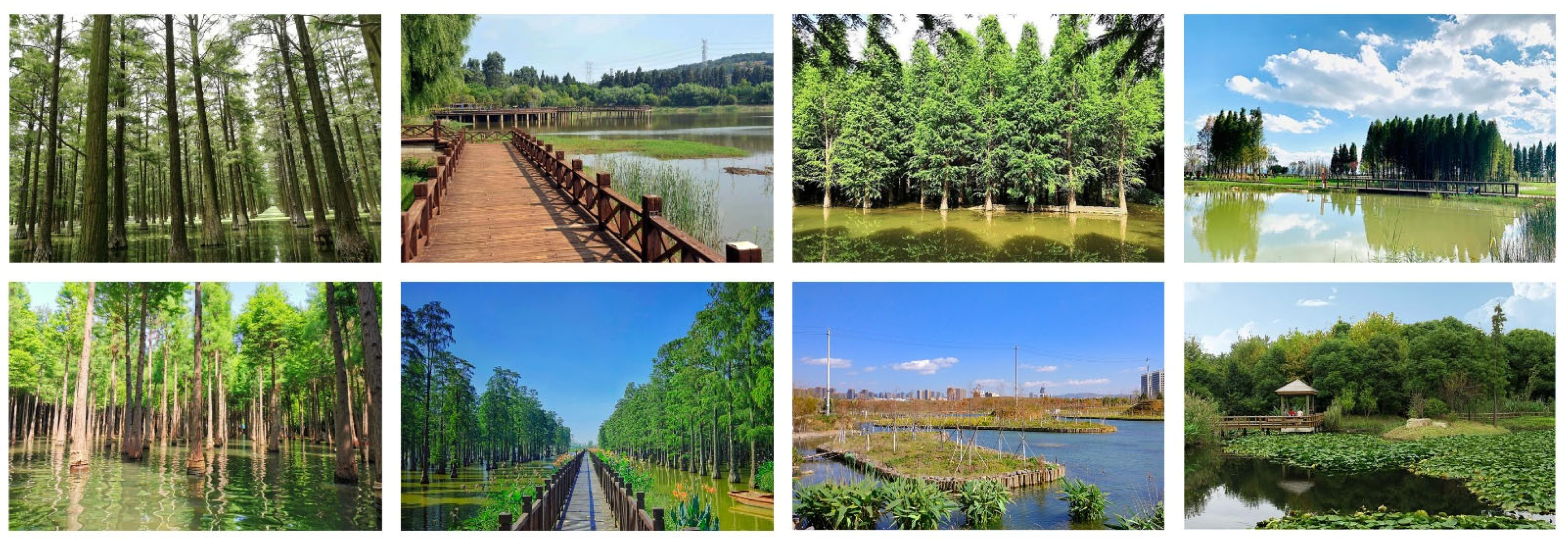
Appendix B


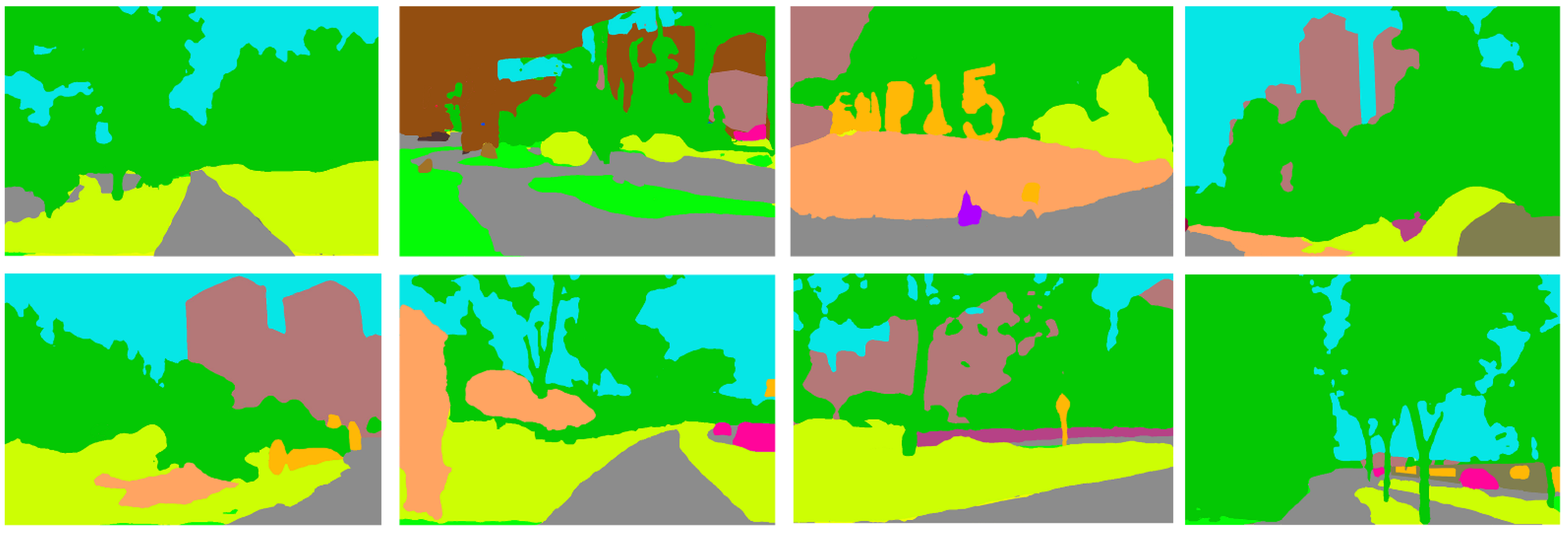

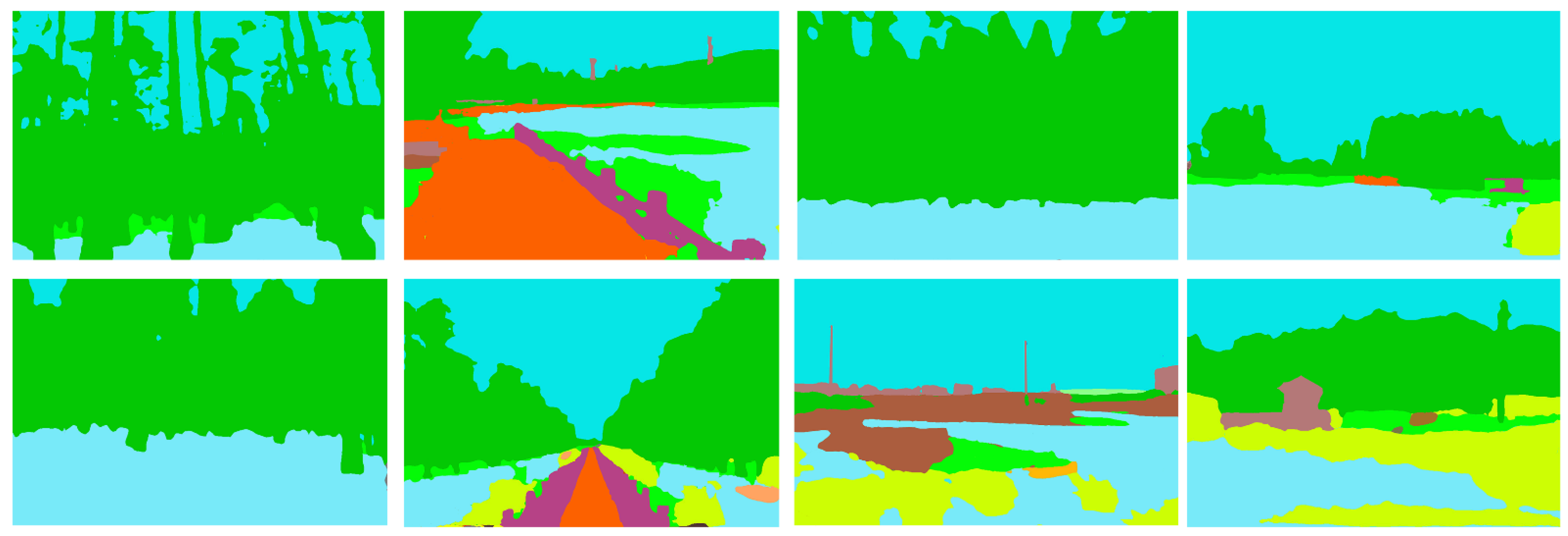
Appendix C
| No. | c Total Effect | a (p) | b (p) | a × b Mediated Effect | 95% Boot CI | c’ Direct Effect | Conclusion |
|---|---|---|---|---|---|---|---|
| Ha | −0.028 * | 0.257 *** | −0.075 *** | −0.019 | −0.204–−0.068 | −0.009 | Fully intermediated |
| Hb1 | 0.077 | −0.535 *** | −0.250 | 0.134 | −1.571–1.952 | −0.143 | Intermediation not significant |
| Hb2 | 0.077 | 0.095 *** | 0.912 | 0.087 | 0.017–0.209 | −0.143 | Fully intermediated |
| Hc1 | −2.437 * | 0.292 *** | −1.177 | −0.344 | −0.148–0.094 | −2.435 | Intermediation not significant |
| Hc2 | −2.437 * | −0.533 *** | −1.944 | 1.036 | −2.185–2.467 | −2.435 | Intermediation not significant |
| Hc3 | −2.437 * | 0.096 *** | −7.226 | −0.694 | −0.239–0.116 | −2.435 | Intermediation not significant |
| Hd1 | 1.176 *** | 0.257 *** | 1.413 | 0.364 | −0.002–0.184 | −9.792 | Intermediation not significant |
| Hd2 | 1.176 *** | 0.095 *** | −0.745 | −0.071 | −0.198–0.162 | −9.792 | Intermediation not significant |
| Hd3 | 1.176 *** | −0.535 *** | −19.972 * | 10.675 | 0.253–4.589 | −9.792 | Fully intermediated |
References
- Gascon, M.; Triguero-Mas, M.; Martínez, D.; Dadvand, P.; Rojas-Rueda, D.; Plasència, A.; Nieuwenhuijsen, M.J. Residential green spaces and mortality: A systematic review. Environ. Int. 2016, 86, 60–67. [Google Scholar] [CrossRef]
- Van den Bosch, M.; Sang, Å.O. Urban natural environments as nature-based solutions for improved public health—A systematic review of reviews. Environ. Res. 2017, 158, 373–384. [Google Scholar] [CrossRef] [PubMed]
- Van den Berg, M.; Wendel-Vos, W.; van Poppel, M.; Kemper, H.; van Mechelen, W.; Maas, J. Health benefits of green spaces in the living environment: A systematic review of epidemiological studies. Urban For. Urban Green. 2015, 14, 806–816. [Google Scholar] [CrossRef]
- Ulrich, R.S. View through a window may influence recovery from surgery. Science 1984, 224, 420–421. [Google Scholar] [CrossRef] [PubMed]
- Maas, J.; Verheij, R.A.; Groenewegen, P.P.; De Vries, S.; Spreeuwenberg, P. Green space, urbanity, and health: How strong is the relation? J. Epidemiol. Community Health 2006, 60, 587–592. [Google Scholar] [CrossRef]
- Barton, J.; Pretty, J. What is the best dose of nature and green exercise for improving mental health? A multi-study analysis. Environ. Sci. Technol. 2010, 44, 3947–3955. [Google Scholar] [CrossRef]
- Orban, E.; Sutcliffe, R.; Dragano, N.; Jöckel, K.-H.; Moebus, S. Residential surrounding greenness, self-rated health and interrelations with aspects of neighborhood environment and social relations. J. Urban Health 2017, 94, 158–169. [Google Scholar] [CrossRef]
- Kalevi, K.; Matti, Y.; Liisa, T.; Harri, S. Determinants of restorative experiences in everyday favorite places. Health Place 2008, 14, 636–652. [Google Scholar]
- Van den Berg, A.E.; Jorgensen, A.; Wilson, E.R. Evaluating restoration in urban green spaces: Does setting type make a difference? Landsc. Urban Plan. 2014, 127, 173–181. [Google Scholar] [CrossRef]
- Hartig, T.; Mang, M.; Evans, G.W. Restorative effects of natural environment experiences. Environ. Behav. 1991, 23, 3–26. [Google Scholar] [CrossRef]
- Xi, W.; Yanlong, Z.H.; Zhao, R.; Niu, L. Study on the Effects of Four Campus GreenLandscapes on College Students‘ Physiologicaland Psychological Indicators. Chin. Landsc. Archit. 2020, 36, 92–97. [Google Scholar] [CrossRef]
- Gao, Y.; Huang, H.; Ye, J.; Li, Z.; Zheng, Y. Influence of Landscape Naturalness Degree in Campus Green Spaceson Human Physiological and Psychological Indicators. J. Chin. Urban For. 2022, 20, 103–109. [Google Scholar]
- Lai, K.Y.; Sarkar, C.; Sun, Z.; Scott, I. Are greenspace attributes associated with perceived restorativeness? A comparative study of urban cemeteries and parks in Edinburgh, Scotland. Urban For. Urban Green. 2020, 53, 126720. [Google Scholar] [CrossRef]
- Huang, C.; Chang, C.; Chang, W. A Study of Human’s Relax Affection in Different Natural Landscape Photos—Evidences from Neuroscience. Data Res. 2019, 3, 13. [Google Scholar] [CrossRef]
- Wang, Y.; Xu, M. Electroencephalogram application for the analysis of stress relief in the seasonal landscape. Int. J. Environ. Res. Public Health 2021, 18, 8522. [Google Scholar] [CrossRef]
- Mackay, G.J.; Neill, J.T. The effect of “green exercise” on state anxiety and the role of exercise duration, intensity, and greenness: A quasi-experimental study. Psychol. Sport Exerc. 2010, 11, 238–245. [Google Scholar] [CrossRef]
- Ryan, R.M.; Weinstein, N.; Bernstein, J.; Brown, K.W.; Mistretta, L.; Gagné, M. Vitalizing effects of being outdoors and in nature. J. Environ. Psychol. 2010, 30, 159–168. [Google Scholar] [CrossRef]
- Berman, M.G.; Jonides, J.; Kaplan, S. The cognitive benefits of interacting with nature. Psychol. Sci. 2008, 19, 1207–1212. [Google Scholar] [CrossRef]
- Wang, X.; Rodiek, S.; Wu, C.; Chen, Y.; Li, Y. Stress recovery and restorative effects of viewing different urban park scenes in Shanghai, China. Urban For. Urban Green. 2016, 15, 112–122. [Google Scholar] [CrossRef]
- Jiang, M.; Hassan, A.; Chen, Q.; Liu, Y. Effects of different landscape visual stimuli on psychophysiological responses in Chinese students. Indoor Built Environ. 2020, 29, 1006–1016. [Google Scholar] [CrossRef]
- Huang, Y.; Fu, W.; Weng, Y.; Wang, M. A Study on the Relationship between Individual Landscape Preference, Perceived Restorativeness Scale and Health Benefits Assessment of Urban Forest Pathway—A Case Study of Fudao. Chin. Landsc. Archit. 2020, 36, 73–78. [Google Scholar] [CrossRef]
- Sun, Y.; Wang, X.; Zhu, J.; Chen, L.; Jia, Y.; Lawrence, J.M.; Jiang, L.-H.; Xie, X.; Wu, J. Using machine learning to examine street green space types at a high spatial resolution: Application in Los Angeles County on socioeconomic disparities in exposure. Sci. Total Environ. 2021, 787, 147653. [Google Scholar] [PubMed]
- Reyes-Riveros, R.; Altamirano, A.; De La Barrera, F.; Rozas-Vásquez, D.; Vieli, L.; Meli, P. Linking public urban green spaces and human well-being: A systematic review. Urban For. Urban Green. 2021, 61, 127105. [Google Scholar] [CrossRef]
- Wood, L.; Hooper, P.; Foster, S.; Bull, F. Public green spaces and positive mental health–investigating the relationship between access, quantity and types of parks and mental wellbeing. Health Place 2017, 48, 63–71. [Google Scholar] [CrossRef]
- Zhu, S.-X.; Hu, F.-F.; He, S.-Y.; Qiu, Q.; Su, Y.; He, Q.; Li, J.-Y. Comprehensive evaluation of healthcare benefits of different forest types: A case study in Shimen National Forest Park, China. Forests 2021, 12, 207. [Google Scholar] [CrossRef]
- Yang, C.; Tan, S.; Chen, L.; Hu, Y. An ESs-based perspective of urban natural health benefits: Service efficacy, cascadinglogic and assessment framework. Chin. Landsc. Archit. 2022, 38, 97. [Google Scholar]
- Qi, T.; Zhang, G.; Wang, Y.; Liu, C.; Li, X. Research on landscape quality of country parks in Beijing as based on visual and audible senses. Urban For. Urban Green. 2017, 26, 124–138. [Google Scholar] [CrossRef]
- Sang, K.; Fontana, G.L.; Piovan, S.E. Assessing railway landscape by AHP process with GIS: A study of the yunnan-vietnam railway. Remote Sens. 2022, 14, 603. [Google Scholar] [CrossRef]
- Sheng, K.; Liu, L.; Wang, F.; Li, S.; Zhou, X. An Eye-Tracking Study on Exploring Children’s Visual Attention to Streetscape Elements. Buildings 2025, 15, 605. [Google Scholar] [CrossRef]
- Zhang, D.; Chen, H.; Zhang, X.; Tan, L. Evaluation of Landscapes and Soundscapes in Traditional Villages in the Hakka Region of Guangdong Province Based on Audio-Visual Interactions. Buildings 2025, 15, 259. [Google Scholar] [CrossRef]
- Kittler, J.; Illingworth, J. Minimum error thresholding. Pattern Recognit. 1986, 19, 41–47. [Google Scholar] [CrossRef]
- Li, E.-S.; Zhu, S.-L.; Zhu, B.-S.; Zhao, Y.; Xia, C.-G.; Song, L.-H. An adaptive edge-detection method based on the canny operator. In Proceedings of the 2009 International Conference on Environmental Science and Information Application Technology, Wuhan, China, 4–5 July 2009; pp. 465–469. [Google Scholar]
- Tremeau, A.; Borel, N. A region growing and merging algorithm to color segmentation. Pattern Recognit. 1997, 30, 1191–1203. [Google Scholar]
- Long, J.; Shelhamer, E.; Darrell, T. Fully convolutional networks for semantic segmentation. In Proceedings of the IEEE Conference on Computer Vision and Pattern Recognition, Boston, MA, USA, 7–12 June 2015; pp. 3431–3440. [Google Scholar]
- Liang-Chieh, C.; Papandreou, G.; Kokkinos, I.; Murphy, K.; Yuille, A. Semantic image segmentation with deep convolutional nets and fully connected CRFS. In Proceedings of the International Conference on Learning Representations, San Diego, CA, USA, 7–9 May 2015. [Google Scholar]
- Zhao, H.; Shi, J.; Qi, X.; Wang, X.; Jia, J. Pyramid scene parsing network. In Proceedings of the IEEE Conference on Computer Vision and Pattern Recognition, Honolulu, HI, USA, 21–26 July 2017; pp. 2881–2890. [Google Scholar]
- Hu, A.; Yabuki, N.; Fukuda, T.; Kaga, H.; Takeda, S.; Matsuo, K. Harnessing multiple data sources and emerging technologies for comprehensive urban green space evaluation. Cities 2023, 143, 104562. [Google Scholar]
- Party History Research Office of the Communist Party of China Kunming Municipal Committee; Office of Kunming Municipal Local Chronicles Compilation Committee. Kunming Nianjian 2023; The Nationalities Publishing House of Yunnan: Kunming, China, 2024. [Google Scholar]
- Huang, S.; Zhneg, Y.; Cheng, L.; Ji, C.; Wang, S.; Dong, J. The impact mechanism of urban park health benefit evaluationbased on landscape preference. J. Nanjing For. Univ. (Nat. Sci. Ed.) 2022, 46, 221. [Google Scholar]
- Fu, H.; Guan, J.; Zhong, Q.; Fu, L.; Jian, Y.; Li, J. Landscape Elements, ecosystem services and users’ Happiness: An indicator framework for park management based on cognitive appraisal theory. Ecol. Indic. 2024, 165, 112209. [Google Scholar] [CrossRef]
- Zou, J.; Jiang, H.; Ying, W.; Qiu, B. Scenic Influences on Walking Preferences in Urban Forest Parks from Top-View and Eye-Level Perspectives. Forests 2024, 15, 2020. [Google Scholar] [CrossRef]
- Zhang, J.; Zhang, X.; Yuan, Y.; Zhu, L. Landscape Evaluation of Different Types of Streets Based on Street View Images. J. Shandong For. Sci. Technol. 2021, 51, 53–60. [Google Scholar]
- Li, Z.; Kang, J. Sensitivity analysis of changes in human physiological indicators observed in soundscapes. Landsc. Urban Plan. 2019, 190, 103593. [Google Scholar]
- Yi, K.; Zhang, J.; Zhang, Z.; Shi, X.; Du, W.; Yang, L.; Wei, M. Differences in Public Perceptions of Recovery in Different Urban Forests Based on Birdsong. Forests 2024, 15, 2217. [Google Scholar] [CrossRef]
- Zhang, Z. Public Response to Characteristics of Forest Color and Its Influence: A Case Study of Forest in Autumn of Jiuzhai Valley, Sichuan Province. Ph.D. Thesis, Chinese Academy of Forestry, Beijing, China, 2017. [Google Scholar]
- Kaplan, S. The restorative benefits of nature: Toward an integrative framework. J. Environ. Psychol. 1995, 15, 169–182. [Google Scholar]
- Rennit, P.; Maikov, K. Perceived restoration scale method turned into (used as the) evaluation tool for parks and open green spaces, using Tartu city parks as an example. City Territ. Archit. 2015, 2, 6. [Google Scholar]
- Huang, S.; Qi, J.; Li, W.; Dong, J.; van den Bosch, C.K. The Contribution to Stress Recovery and Attention Restoration Potential of Exposure to Urban Green Spaces in Low-Density Residential Areas. Int. J. Environ. Res. Public Health 2021, 18, 8713. [Google Scholar] [CrossRef] [PubMed]
- Dupont, L.; Ooms, K.; Antrop, M.; Eetvelde, V.V. Comparing saliency maps and eye-tracking focus maps: The potential use in visual impact assessment based on landscape photographs. Landsc. Urban Plan. 2016, 148, 17–26. [Google Scholar]
- Boya, Y.; Jie, B.; Linjie, W.; Yuying, C. Psychophysiological Impacts of Traffic Sounds in Urban Green Spaces. Forests 2022, 13, 960. [Google Scholar] [CrossRef]
- Peng, W.; Youjun, H.; Wenjuan, Y.; Nan, L.; Jiaojiao, C. Effects of Soundscapes on Human Physiology and Psychology in Qianjiangyuan National Park System Pilot Area in China. Forests 2022, 13, 1461. [Google Scholar] [CrossRef]
- Shi, H.; Luo, H.; Wei, Y.; Shin, W.-S. The influence of different forest landscapes on physiological and psychological recovery. Forests 2024, 15, 498. [Google Scholar] [CrossRef]
- Williamson, I.; Wildbur, D.; Bell, K.; Tanner, J.; Matthews, H. Benefits to university students through volunteering in a health context: A new model. Br. J. Educ. Stud. 2018, 66, 383–402. [Google Scholar]
- Calogiuri, G.; Evensen, K.; Weydahl, A.; Andersson, K.; Patil, G.; Ihlebæk, C.; Raanaas, R.K. Green exercise as a workplace intervention to reduce job stress. Results from a pilot study. Work 2015, 53, 99–111. [Google Scholar]
- Liu, B.; Lian, Z.; Brown, R.D. Effect of Landscape Microclimates on Thermal Comfort and Physiological Wellbeing. Sustainability 2019, 11, 5387. [Google Scholar] [CrossRef]
- Shen, H.; He, X.; He, J.; Li, D.; Liang, M.; Xie, X. Back to the village: Assessing the effects of naturalness, landscape types, and landscape elements on the restorative potential of rural landscapes. Land 2024, 13, 910. [Google Scholar] [CrossRef]
- Zhao, W.; Li, X.; Zhu, X.; Ye, H.; Xu, H. Restorative properties of green sheltered spaces and their morphological characteristics in urban parks. Urban For. Urban Green. 2023, 86, 127986. [Google Scholar]
- Picavet, H.S.J.; Milder, I.; Kruize, H.; De Vries, S.; Hermans, T.; Wendel-Vos, W. Greener living environment healthier people?: Exploring green space, physical activity and health in the Doetinchem Cohort Study. Prev. Med. 2016, 89, 7–14. [Google Scholar] [PubMed]
- Chen, Z.; Zhai, X.Q.; Ye, S.Y.; Zhang, Y.; Yu, J. A Meta-analysis of Restorative Nature Landscapes and Mental Health Benefits on Urban Residentsand Its Planning Implication. Urban Plan. Int. 2016, 31, 16–26. [Google Scholar]
- Xiaoyue, Z. Research on the Influence of Types and Features of Blue-Green Space on Pressure Recovery. Master’s Thesis, Harbin Institute of Technology, Harbin, China, 2019. [Google Scholar]
- Zhu, J.; Lin, X.; Shao, H.; Li, W.; Dong, J.; Zheng, Y. Research on the lmpact of Forest Park Landscape Elements on Health Benefits Based on Multi-source Data. J. Northwest For. Univ. 2024, 41, 634–643. Available online: https://zlxb.zafu.edu.cn/cn/article/doi/10.11833/j.issn.2095-0756.20230534 (accessed on 27 December 2024).
- Francová, A.; Jablonská, M.; Fajnerová, I. Design and evaluation of virtual reality environments for claustrophobia. PRESENCE Virtual Augment. Real. 2023, 32, 23–34. [Google Scholar]
- Johnson, T.; Burgoyne, A.P.; Mix, K.S.; Young, C.J.; Levine, S.C. Spatial and mathematics skills: Similarities and differences related to age, SES, and gender. Cognition 2022, 218, 104918. [Google Scholar]
- Jiang, S.; Liu, J. Comparative Study of Cultural Landscape Perception in Historic Districts from the Perspectives of Tourists and Residents. Land 2024, 13, 353. [Google Scholar] [CrossRef]
- Poderoso, R.A.; Peroni, N.; Hanazaki, N. Gender influences in the perception and use of the landscape in a rural community of German immigrant descendants in Brazil. J. Ethnobiol. 2017, 37, 779–797. [Google Scholar]
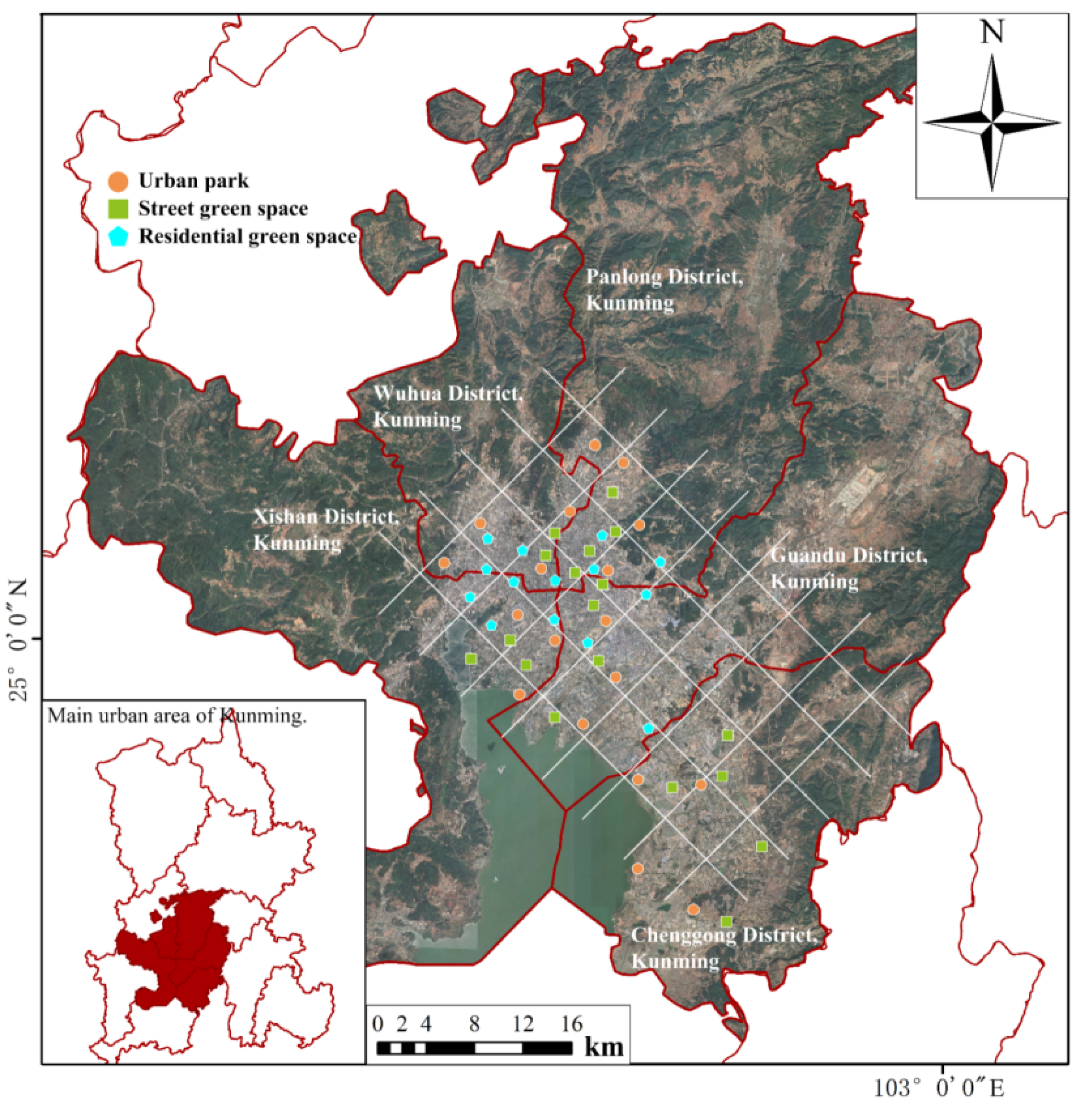

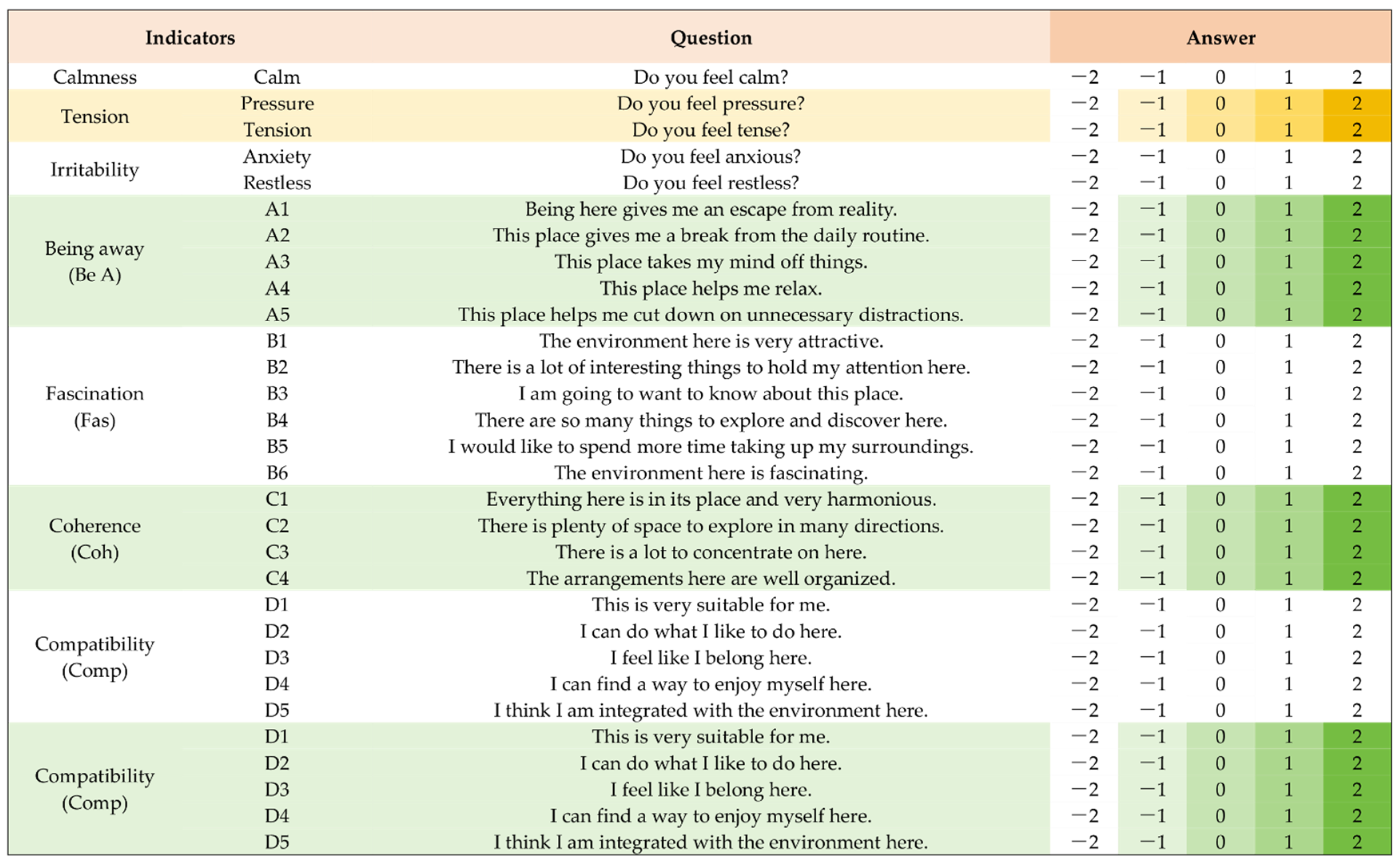


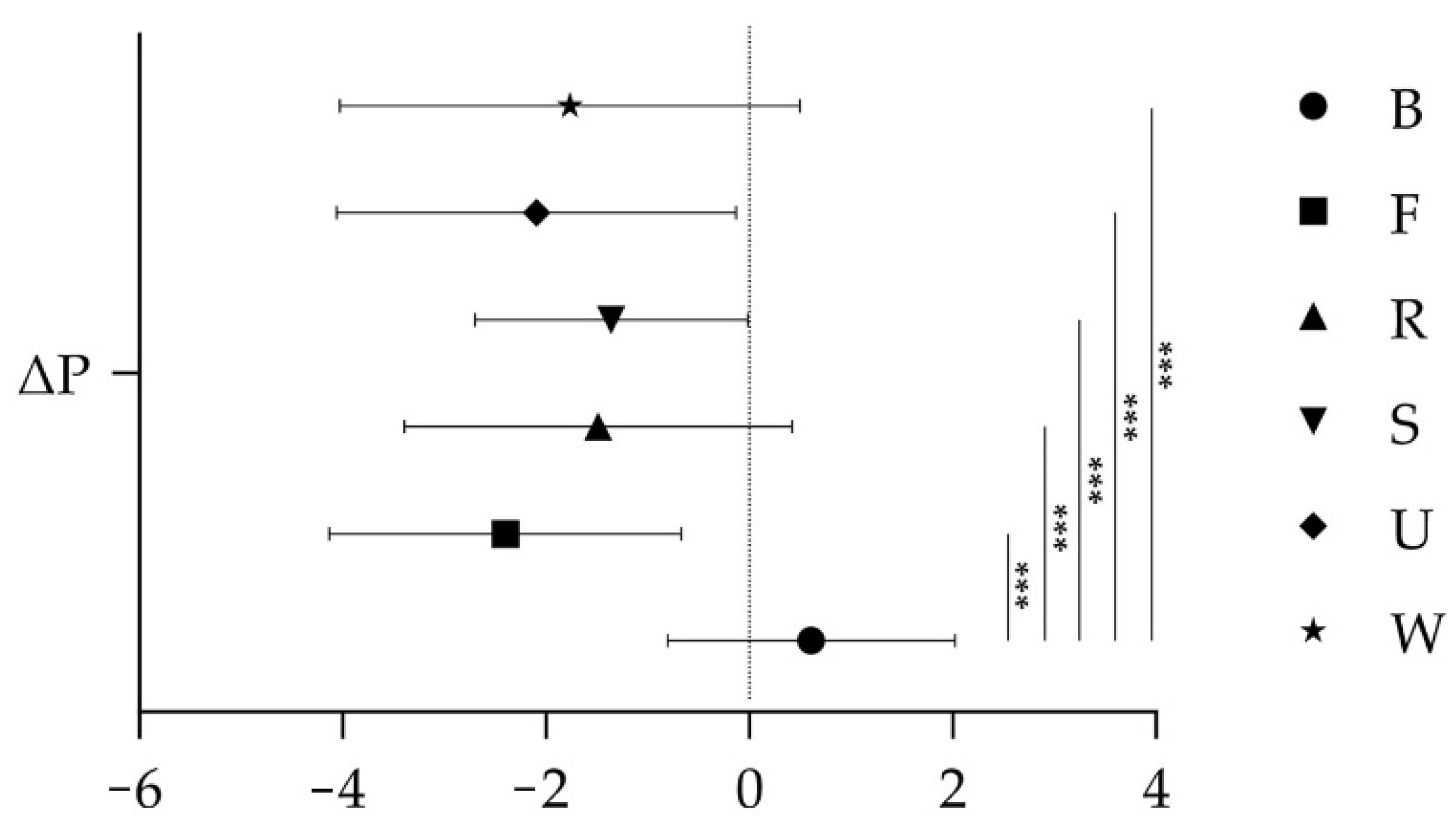
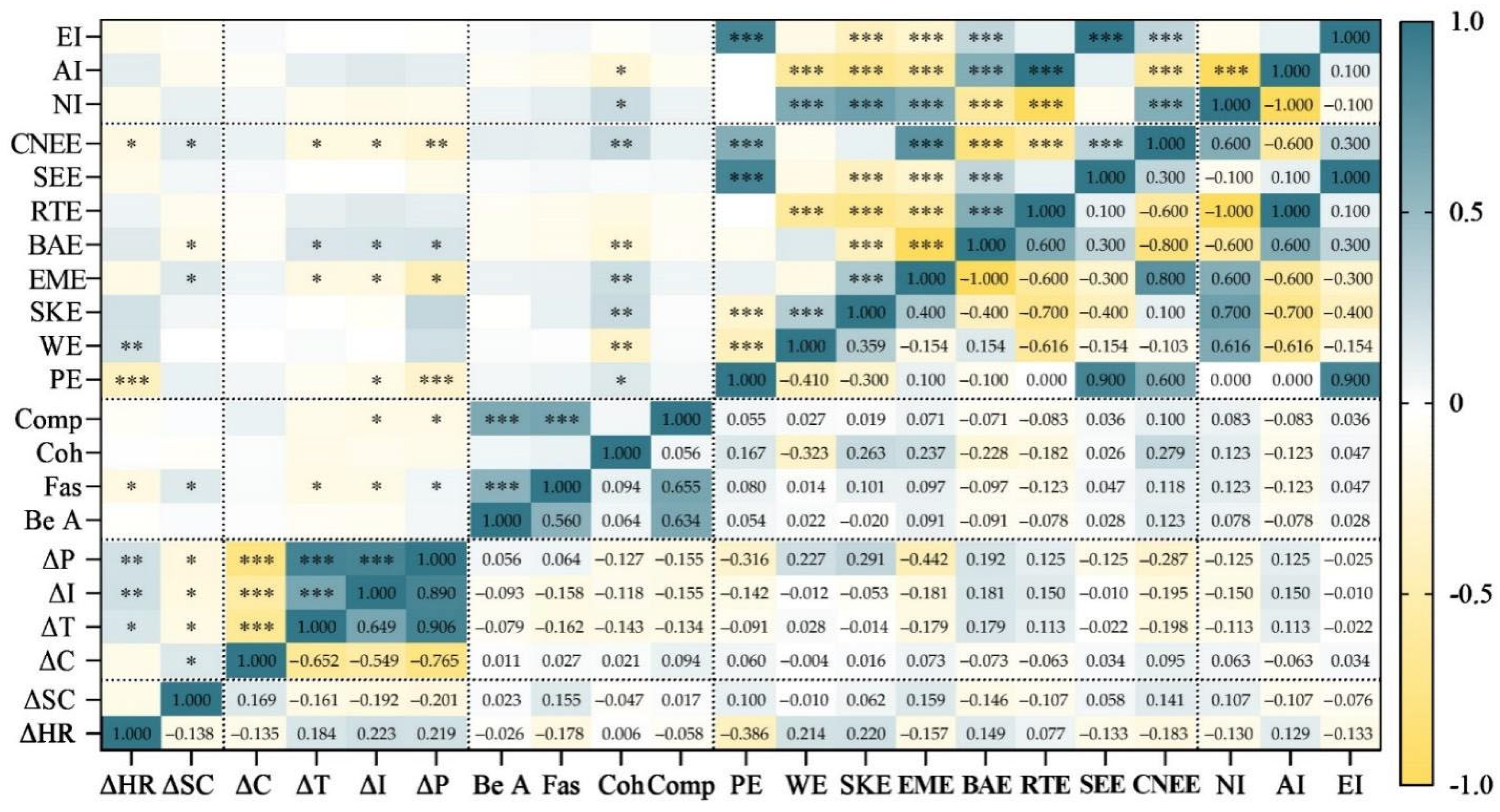
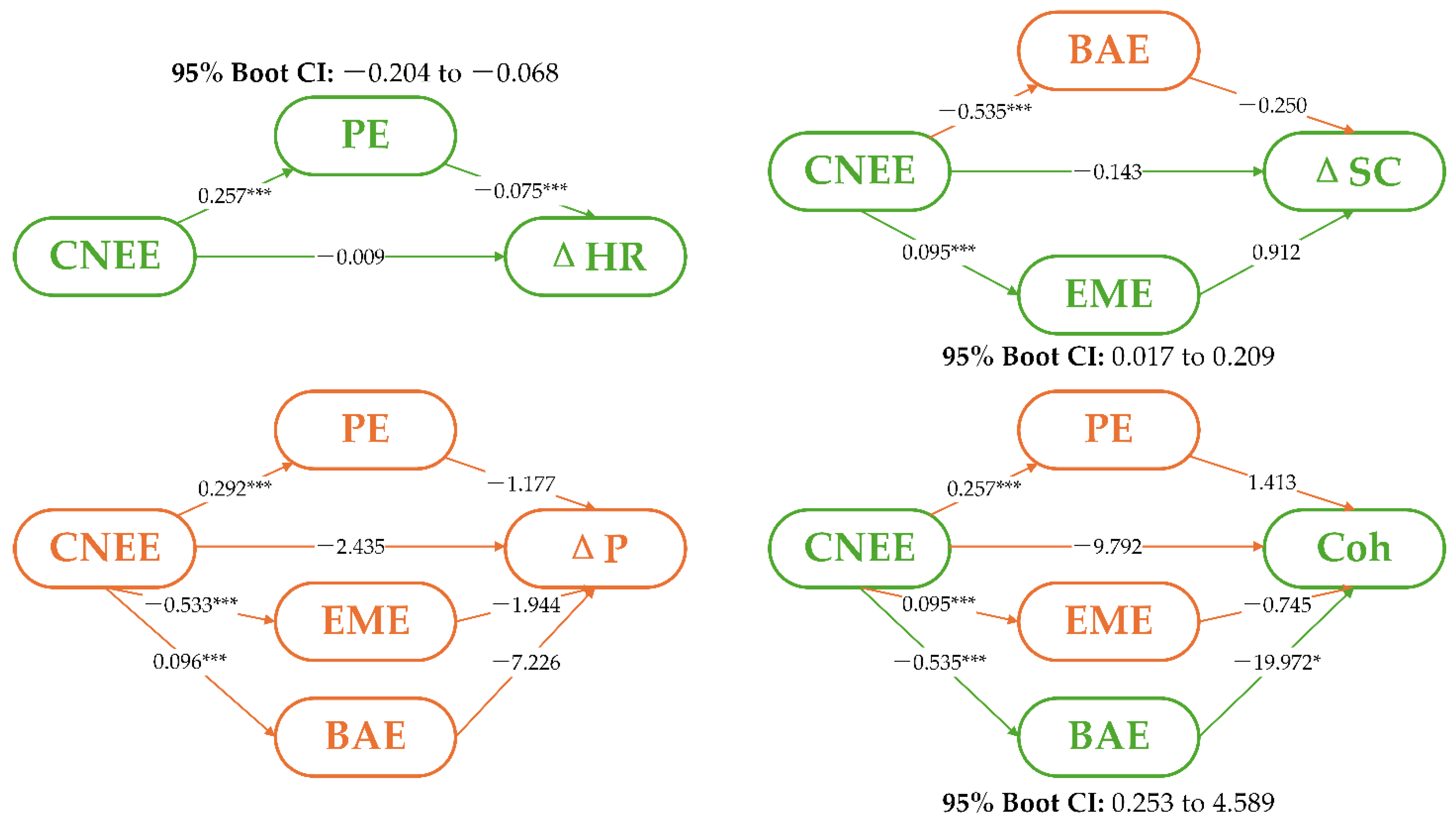
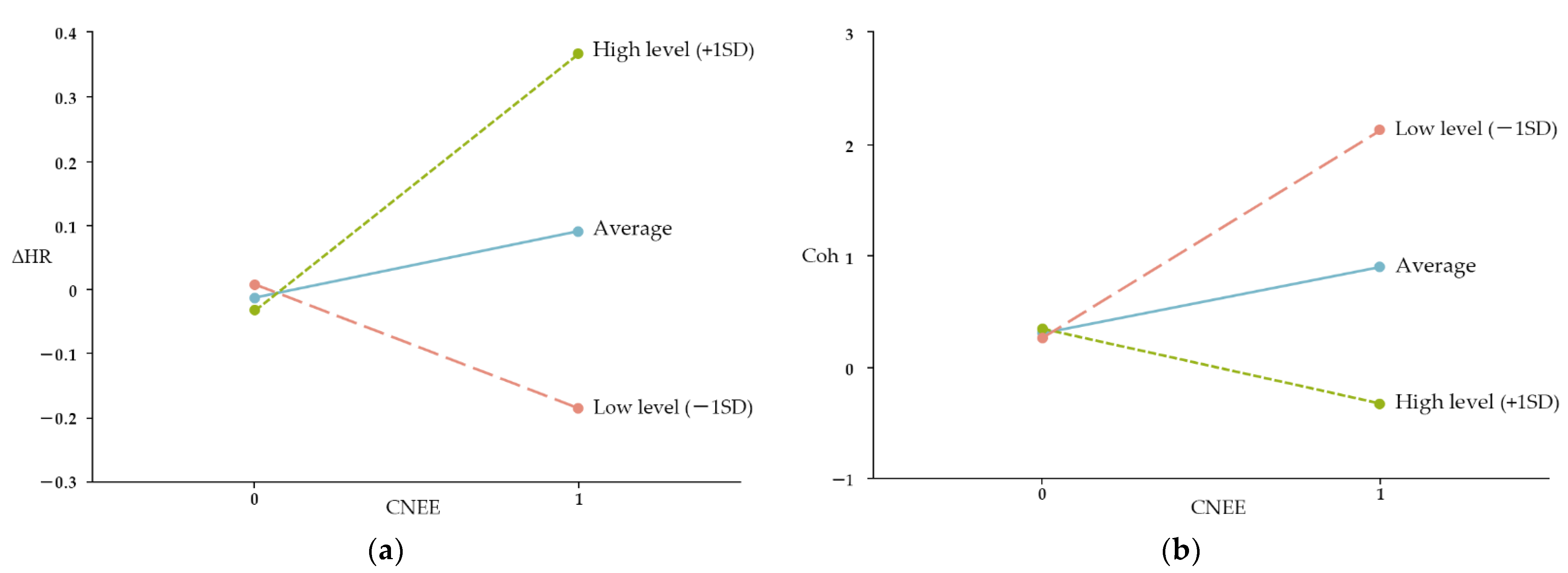
| Landscape Element Index | Type of Landscape Element | Element | ||
|---|---|---|---|---|
| Index | Calculation Method | Type | Calculation Method | |
| Naturalness Index (NI) | Sum of PE, WE, SKE and EME in the environment. | Plant Element (PE) | Sum of the percentage of Tree, Shrub, Grass, and Flower in the environment. | Tree |
| Shrub | ||||
| Grass | ||||
| Flower | ||||
| Water Element (WE) | Percentage of Water in the environment. | Water (including lakes, rivers, etc.) | ||
| Sky Element (SKE) | Percentage of Sky in the environment. | Sky | ||
| Earth and Mountain Element (EME) | Sum of the percentage of Earth, Mountain, and Rock in the environment. | Mountain | ||
| Earth | ||||
| Rock | ||||
| Artificiality Index (AI) | Sum of BAE and RTE in the environment. | Building and Artificial Element (BAE) | Sum of the percentage of Building, Wall, Fence, Signboard, Trash and Landscape Seats in the environment. | Building |
| Wall | ||||
| Fence | ||||
| Signboard | ||||
| Trash | ||||
| Landscape Seats | ||||
| Lamp | ||||
| Roads and Traffic Element (RTE) | Sum of the percentage of Road, Sidewalk, Car, Bridge and Boat in the environment. | Road | ||
| Sidewalk | ||||
| Car | ||||
| Bridge | ||||
| Boat | ||||
| Enclosure Index (EI) | EI equals SEE of the environment. | Spatial Enclosure Element (SEE) | Sum of the percentage of Tree, Mountain, Building, Wall and Fence in the environment. | - |
| Contribution of Natural Element to Enclosure (CNEE) | The contribution of the Tree and Mountain in SEE. | - | ||
| PE | WE | SKE | EME | BAE | RTE | SEE | CNEE | NI | AI | EI | |
|---|---|---|---|---|---|---|---|---|---|---|---|
| F | 74.16% | 0.00% | 11.41% | 5.46% | 2.00% | 7.08% | 56.75% | 96.48% | 91.03% | 9.08% | 56.75% |
| R | 64.24% | 1.65% | 4.49% | 0.00% | 19.33% | 10.27% | 56.97% | 66.08% | 70.39% | 29.60% | 56.97% |
| S | 57.16% | 0.00% | 11.75% | 0.17% | 17.94% | 12.97% | 51.10% | 64.89% | 69.08% | 30.91% | 51.10% |
| U | 76.74% | 1.37% | 14.10% | 0.82% | 3.36% | 3.58% | 61.59% | 95.37% | 93.03% | 6.94% | 61.59% |
| W | 48.21% | 19.99% | 23.30% | 1.93% | 3.32% | 3.23% | 43.40% | 92.35% | 93.44% | 6.55% | 43.40% |
| Environment Groups (Mean ± SD) | F | p | ||||||
|---|---|---|---|---|---|---|---|---|
| B | F | R | S | U | W | |||
| ΔHR | 0.073 ± 0.147 | −0.013 ± 0.037 | −0.004 ± 0.023 | 0.012 ± 0.025 | −0.008 ± 0.053 | 0.010 ± 0.067 | 3.794 | 0.004 ** |
| ΔSC | −0.058 ± 0.154 | 0.068 ± 0.132 | 0.030 ± 0.142 | 0.010 ± 0.131 | 0.079 ± 0.129 | 0.054 ± 0.128 | 3.863 | 0.002 ** |
| Environment Groups (Mean ± SD) | F | p | ||||||
|---|---|---|---|---|---|---|---|---|
| B | F | R | S | U | W | |||
| ΔC | −0.200 ± 0.961 | 1.000 ± 1.114 | 0.733 ± 0.980 | 0.700 ± 0.837 | 0.900 ± 0.995 | 0.800 ± 0.067 | 5.620 | 0.000 *** |
| ΔT | 0.767 ± 1.654 | −2.800 ± 2.203 | −1.700 ± 2.395 | −1.567 ± 1.675 | −2.367 ± 2.428 | −2.167 ± 2.394 | 10.313 | 0.000 *** |
| ΔI | 0.633 ± 1.884 | −2.500 ± 2.047 | −1.467 ± 2.315 | −1.300 ± 1.622 | −2.233 ± 2.161 | −1.667 ± 3.417 | 9.291 | 0.000 *** |
| ΔP | 0.610 ± 1.415 | −2.399 ± 1.732 | −1.484 ± 1.906 | −1.357 ± 1.342 | −2.093 ± 1.964 | −1.765 ± 2.260 | 14.055 | 0.000 *** |
| Environment Groups (Mean ± SD) | F | p | |||||
|---|---|---|---|---|---|---|---|
| F | R | S | U | W | |||
| Be A | 0.59 ± 0.59 | 0.45 ± 0.71 | 0.41 ± 0.51 | 0.53 ± 0.65 | 0.49 ± 0.72 | 0.393 | 0.814 |
| Fas | 0.59 ± 0.59 | 0.38 ± 0.59 | 0.48 ± 0.45 | 0.61 ± 0.63 | 0.52 ± 0.68 | 0.708 | 0.588 |
| Coh | 0.42 ± 0.80 | −0.16 ± 0.73 | 0.13 ± 0.59 | 0.33 ± 0.77 | 0.22 ± 0.79 | 2.716 | 0.032 * |
| Comp | 0.47 ± 0.85 | 0.33 ± 0.83 | 0.30 ± 0.68 | 0.41 ± 0.95 | 0.39 ± 1.07 | 0.171 | 0.953 |
| Number (No.) | Impact Path | Number (No.) | Impact Path |
|---|---|---|---|
| Ha | CNEE→PE→ΔHR | Hc3 | CNEE→BAE→ΔP |
| Hb1 | CNEE→BAE→ΔSC | Hd1 | CNEE→PE→Coh |
| Hb2 | CNEE→EME→ΔSC | Hd2 | CNEE→EME→Coh |
| Hc1 | CNEE→PE→ΔP | Hd3 | CNEE→BAE→Coh |
| Hc2 | CNEE→EME→ΔP | - | - |
| Model 1 | Model 2 | Model 3 | |||||
|---|---|---|---|---|---|---|---|
| Beta (SE) | t (p) | Beta (SE) | t (p) | Beta (SE) | t (p) | ||
| X: CNEE Y: ΔHR M: WE | const | 0.000 (0.002) | 0.000 | 0.000(0.002) | 0.000 | −0.013(0.004) | −3.150 *** |
| CNEE | −0.028(0.012) | −2.311 * | −0.043(0.012) | −3.581 *** | 0.104(0.045) | 2.316 * | |
| WE | 0.091(0.022) | 4.052 *** | −0.263(0.107) | −2.471 * | |||
| CNEE × WE | 3.833(1.129) | 3.395 *** | |||||
| F, ΔF | F = 5.341 *, ΔF = 5.431 * | F = 11.158 ***, ΔF = 16.419 *** | F = 11.813 ***, ΔF = 11.526 ** | ||||
| X: CNEE Y: Coh M: WE | const | 0.192 (0.048) | 4.009 *** | 0.192(0.048) | 4.009 *** | −0.034(0.127) | −0.269 |
| CNEE | 1.176(0.332) | 3.541 ** | 1.288(0.350) | 3.681 *** | 3.759(1.335) | 2.815 ** | |
| WE | −0.661(0.652) | −1.014 | −6.624(3.178) | −2.084 * | |||
| CNEE × WE | 64.490(33.652) | 1.916 | |||||
| F, ΔF | F = 12.541 **, ΔF = 12.541 ** | F = 6.785 **, ΔF = 1.082 | F = 5.830 **, ΔF= 3.672 | ||||
| X: CNEE Y: Coh M: SKE | const | 0.192(0.048) | 4.009 *** | 0.192(0.048) | 3.995 *** | 0.298(0.067) | 4.473 *** |
| CNEE | 1.176(0.332) | 3.541 ** | 1.140(0.411) | 2.776 ** | 0.595(0.471) | 1.263 | |
| SKE | 0.147(0.975) | 0.151 | 0.651(0.987) | 0.660 | |||
| CNEE × SKE | −20.815(9.187) | −2.266 * | |||||
| F, ΔF | F = 12.541 **, ΔF = 12.541 ** | F = 6.240 **, ΔF = 0.023 | F = 5.988 **, ΔF = 5.133 * | ||||
Disclaimer/Publisher’s Note: The statements, opinions and data contained in all publications are solely those of the individual author(s) and contributor(s) and not of MDPI and/or the editor(s). MDPI and/or the editor(s) disclaim responsibility for any injury to people or property resulting from any ideas, methods, instructions or products referred to in the content. |
© 2025 by the authors. Licensee MDPI, Basel, Switzerland. This article is an open access article distributed under the terms and conditions of the Creative Commons Attribution (CC BY) license (https://creativecommons.org/licenses/by/4.0/).
Share and Cite
Yi, K.; Shi, X.; Wei, M.; Zhang, Z. Benefits of Various Urban Green Spaces for Public Health Based on Landscape Elements: A Study of Public Visual Perception. Forests 2025, 16, 648. https://doi.org/10.3390/f16040648
Yi K, Shi X, Wei M, Zhang Z. Benefits of Various Urban Green Spaces for Public Health Based on Landscape Elements: A Study of Public Visual Perception. Forests. 2025; 16(4):648. https://doi.org/10.3390/f16040648
Chicago/Turabian StyleYi, Kaiyuan, Xiaoyan Shi, Meng Wei, and Zhe Zhang. 2025. "Benefits of Various Urban Green Spaces for Public Health Based on Landscape Elements: A Study of Public Visual Perception" Forests 16, no. 4: 648. https://doi.org/10.3390/f16040648
APA StyleYi, K., Shi, X., Wei, M., & Zhang, Z. (2025). Benefits of Various Urban Green Spaces for Public Health Based on Landscape Elements: A Study of Public Visual Perception. Forests, 16(4), 648. https://doi.org/10.3390/f16040648






